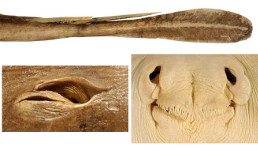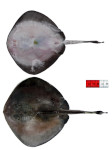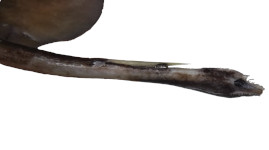Trygonoptera imitata
Yearsley, Last & Gomon, 2008
Eastern shovelnose stingaree
Classification: Elasmobranchii Myliobatiformes Urolophidae
Reference of the original description
Trygonoptera imitata sp. nov., a new stingaree (Myliobatoidei: Urolophidae) from southeastern Australia. CSIRO Marine and Atmospheric Research Paper, 22, 261–268
Trygonoptera imitata sp. nov., a new stingaree (Myliobatoidei: Urolophidae) from southeastern Australia. CSIRO Marine and Atmospheric Research Paper, 22, 261–268
Image of the original description
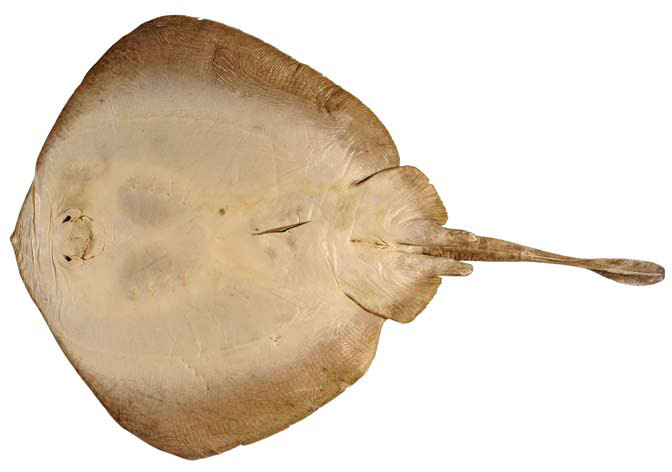
Trygonoptera imitata sp. nov, adult male holotype (CSIRO H 3548–01, 613 mm TL, preserved): ventral view. In: Yearsley, G.K. & Last, P.R. & Gomon, M.F. (2008): Trygonoptera imitata sp. nov, a new stingaree (Myliobatoidei: Urolophidae) from southeastern Australia. CSIRO Marine and Atmospheric Research Paper, 22: 261-268

Trygonoptera imitata sp. nov, adult male holotype (CSIRO H 3548–01, 613 mm TL, preserved): ventral view. In: Yearsley, G.K. & Last, P.R. & Gomon, M.F. (2008): Trygonoptera imitata sp. nov, a new stingaree (Myliobatoidei: Urolophidae) from southeastern Australia. CSIRO Marine and Atmospheric Research Paper, 22: 261-268
Types
Trygonoptera imitata
Holotype: CSIRO: H 3548-01; Paratype: AMS: I.44170-001; CSIRO: H 869-01; CSIRO: H 999-07; CSIRO: H 3718-04; CSIRO: H 4441-03; CSIRO: H 4441-05; CSIRO: H 3718-02; CSIRO: H 3718-03; CSIRO: H 35-01; CSIRO: H 3532-07; CSIRO: H 3717-01; CSIRO: H 2670-01; CSIRO: H 2670-02; CSIRO: H 1002-02; NMV: A 10830; NMV: A 10832; NMV: A 10825;
Trygonoptera imitata
Holotype: CSIRO: H 3548-01; Paratype: AMS: I.44170-001; CSIRO: H 869-01; CSIRO: H 999-07; CSIRO: H 3718-04; CSIRO: H 4441-03; CSIRO: H 4441-05; CSIRO: H 3718-02; CSIRO: H 3718-03; CSIRO: H 35-01; CSIRO: H 3532-07; CSIRO: H 3717-01; CSIRO: H 2670-01; CSIRO: H 2670-02; CSIRO: H 1002-02; NMV: A 10830; NMV: A 10832; NMV: A 10825;
Description :
Citation: Trygonoptera imitata Yearsley, Last & Gomon, 2008: In: Database of modern sharks, rays and chimaeras, www.shark-references.com, World Wide Web electronic publication, Version 12/2025
Please send your images of "Trygonoptera imitata" to info@shark-references.com
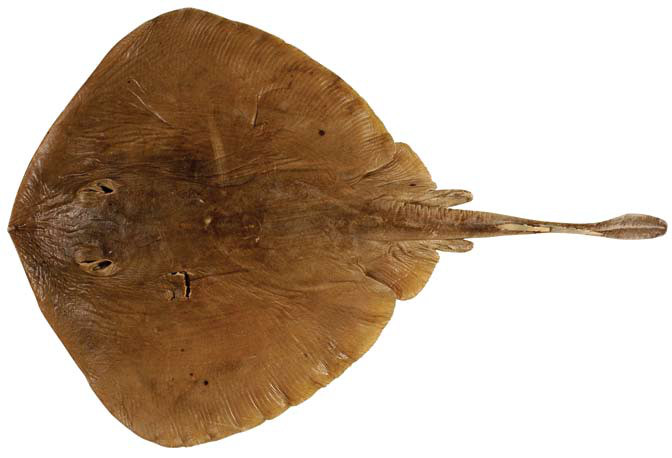
Trygonoptera imitata sp. nov, adult male holotype (CSIRO H 3548–01, 613 mm TL, preserved): dorsal view; In: Yearsley, G.K. & Last, P.R. & Gomon, M.F. (2008): Trygonoptera imitata sp. nov, a new stingaree (Myliobatoidei: Urolophidae) from southeastern Australia. CSIRO Marine and Atmospheric Research Paper, 22: 261-268

Trygonoptera imitata sp. nov, adult male holotype (CSIRO H 3548–01, 613 mm TL, preserved): dorsal view; In: Yearsley, G.K. & Last, P.R. & Gomon, M.F. (2008): Trygonoptera imitata sp. nov, a new stingaree (Myliobatoidei: Urolophidae) from southeastern Australia. CSIRO Marine and Atmospheric Research Paper, 22: 261-268
Common names
 Eastern shovelnose stingaree
Eastern shovelnose stingaree
 Eastern shovelnose stingaree
Eastern shovelnose stingaree
Short Description
Original diagnosis after YEARSLEY, LAST & GOMON, 2008 [3350]: A large plain-coloured Trygonoptera with the following combination of characters: subcircular disc, width 62–67% TL; snout angle 122–129°; distance from snout tip to posterior edge of spiracle 17–19% of TL; eye length 19–24% of preorbital snout length, 9.3–10.9% of ventral head length; inter-eye distance 3.0–4.0 times eye diameter; short prenasal length 8.8–9.8% TL; length of main spiracular opening 1.7–2.3 times eye length; length of first gill slit 2.2–2.6 times in mouth width; tail without cutaneous folds; stinging spine(s) long, 9–13% TL when intact; dorsal fin absent; caudal fin deep (height 3.6–4.1% of TL); pectoral radials 98–107; total vertebral centra about 199–223; total diplospondylous centra about 166–185; uniform greyish brown to yellowish dorsally
Original diagnosis after YEARSLEY, LAST & GOMON, 2008 [3350]: A large plain-coloured Trygonoptera with the following combination of characters: subcircular disc, width 62–67% TL; snout angle 122–129°; distance from snout tip to posterior edge of spiracle 17–19% of TL; eye length 19–24% of preorbital snout length, 9.3–10.9% of ventral head length; inter-eye distance 3.0–4.0 times eye diameter; short prenasal length 8.8–9.8% TL; length of main spiracular opening 1.7–2.3 times eye length; length of first gill slit 2.2–2.6 times in mouth width; tail without cutaneous folds; stinging spine(s) long, 9–13% TL when intact; dorsal fin absent; caudal fin deep (height 3.6–4.1% of TL); pectoral radials 98–107; total vertebral centra about 199–223; total diplospondylous centra about 166–185; uniform greyish brown to yellowish dorsally
Remarks
shark-references Species-ID=7359;
shark-references Species-ID=7359;








